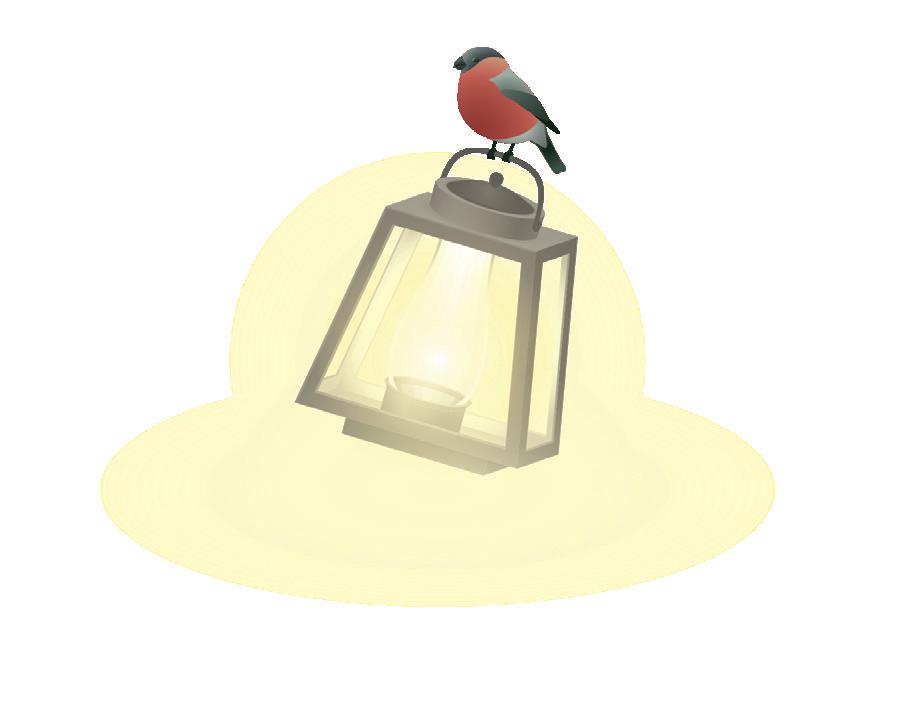
15 minute read
BRENDAN McCONVERY
UP FRONT
BRENDAN McCONVERY CSsR
Advertisement
THE POWER OF THE WORD
This
year marks the 1600 th anniversary of the death of St Jerome. It is an anniversary that is likely to pass unnoticed by the world. It is, however, an anniversary that deserves to be marked for many reasons. If you want to learn some of them, the ideal way might be to read the letter of Pope Francis issued on the occasion of his feast-day, September 30 this year. Letters like this are usually known by their opening Latin words. In this case, we need the whole of the first sentence rather than just its first three words Scripturae Sacrae affectus: “devotion to sacred Scripture, a ‘living and tender love’ for the written word of God: this is the legacy that Saint Jerome bequeathed to the Church by his life and labours.” Pope Francis takes the Bible seriously and he is anxious that we should too. Last year, on the same occasion of the feast of St Jerome, he inaugurated an annual Catholic ‘Bible Sunday’ to be held on the third Sunday of the new liturgical year. Bible Sundays have long been a feature of our sister churches of the Reformation tradition. They produce resources on which we might profitably draw as we prepare of our Bible Sunday on January 24. A good link is the Bible Society (www. biblesocietyni.co.uk for Northern Ireland or www.nationalbiblesocietyofireland.ie for the Republic). Bible groups, parishes and schools that have some time might consider ways of preparing for Bible Sunday now before we are deluged by preparations for Christmas. Some people I know took advantage of the coronavirus lockdown to blow the dust off the neglected family bible and start reading again. The “living and tender love for the written word of God” of which Pope Francis speaks is more than simply rising to the challenge to read a long-forgotten book. The Bible for the believer is above all a book of the heart. The Holy Father uses Jerome’s experience as a way of deepening the human story of our encounter with the Word. He imagines Jerome as an old and experienced sailor passing on his dearly-bought experience to a younger man: “This is what I would like to make you understand, taking you by the hand like an ancient mariner, the survivor of several shipwrecks, attempting to teach a young sailor”. He suggests that to understand St Jerome’s rather complex, and often awkward, personality fully, we need to hold two aspects of his life as a believer in a creative tension. “On the one hand, an absolute and austere consecration to God, renouncing all human satisfaction for love of Christ crucified (cf. 1 Cor 2:2; Phil 3:8.10), and on the other, a commitment to diligent study, aimed purely at an ever deeper understanding of the Christian mystery.” Most of us will be fortunate if we reach the level of consecration to God that is nourished by reading the Gospel story, especially the story of the cross. Few of us will be able to devote ourselves to diligent study, and fewer still to the level Jerome reached. There are some who do it and for them we give thanks. Jerome’s single-handed translation of the whole Bible, which became the official version for centuries of the Latin church, was done with scant resources. Realising that he would need a better grasp of the Hebrew of the Old Testament, he set about finding some one to help him. Hebrew was by then a dead language, familiar through its liturgical use to devout Jews and they too probably had to struggle with its meaning. He recalls three of his Jewish teachers – one from Tiberias who helped him with the translation of Chronicles, another "reputed to be of the highest standing among the Hebrews" led him through the challenging poetry of the Book of Job and Bar Anina who, like Nicodemus and Jesus, “came to him by night at Bethlehem.” Most translations today are done by teams of scholars. The New Revised Standard Version for example, was the work of about 30 scholars all familiar with the original languages as a result of many years teaching and learning, to say nothing of the astonishing range of electronic aids that have taken the place of Jerome’s stylus and ink.
The pope quotes approvingly the philosopher Ludwig Wittgenstein who says “the limits of my language are the limits of my world.” The challenge of making sense of language and meaning is still at the heart of our engagement with the Word. Jerome could fight passionately over a word he thought was incorrect or defend himself when others said he was mistaken. But it is more than just individual words. “One of the problems we face today and not only 11 in religion,” says Pope Francis, “is illiteracy: the skills of interpretation that make us credible interpreters and translators of our own cultural tradition are in short supply. I would like to pose a challenge to young people in particular: begin exploring your heritage. Christianity makes you heirs of an unsurpassed cultural patrimony of which you must take ownership. Be passionate about this history which is yours. Dare to fix your gaze on the young Jerome who, like the merchant in Jesus’ parable, sold all that he had in order to buy the 'pearl of great price' (Mt 13:46).”




ONE HUNDRED YEARS LATER, ARE WE ABLE TO FACE THE TRUTH OF THAT TERRIBLE DAY THAT HAS BECOME PART OF THE IRISH FOLK MEMORY?
It remains the darkest day in the rich history of the GAA. It colours all the pages of memory. It should have been a battle of skill. It became a battle with bullets.
Thirteen people were shot dead by the Black and Tans in Croke Park during a football match between Tipperary and Dublin on November 21, 1920.
BIG MICK
The identity of a people and a nation is determined by a shared recounted story. Bloody Sunday has been central to the ‘Irish story’. The enemy of consideration of Bloody Sunday is lack of nuance. Sowing the seed of nuance though, is tough.
The first challenge is to dispense with the myth.
For many younger and, indeed, older people, their abiding image of that day is that from Neil Jordan’s film Michael Collins: armoured cars with machine guns go into Croke Park and open fire. Jordan would explain his deviation from fact on the understandable grounds that he felt the machine-gunned tank captured the faceless callousness of imperialism more strikingly than soldiers shooting, saying “I wanted the scene to last 30 seconds". The film was about Michael Collins, not Bloody Sunday, but Bloody Sunday went on for much longer than 30 seconds. The sad reality is that the film did not do justice to the visceral bloodbath that was Bloody Sunday.
There comes a point in every story where different outcomes are possible, where roads are taken or not taken. There is a case for beginning the story of Bloody Sunday years earlier to take account of the tensions in Ireland that had been fermenting.
Myths abound about the Black and Tans. Inevitably, the historical reality was more complex and nuanced. While the popular perception was that English society opened up its prisons to let the ‘dregs of humanity’ wreak havoc in Ireland, some of the earliest Black and Tans were, in fact, decorated war veterans. They even included Victoria Cross winners. To these men of honour, the atrocities that some of their counterparts inflicted were repugnant militarily and morally and they left and went back home. Thankfully, in seeking some element of objectivity about them, we now have a much greater understanding of post-traumatic stress syndrome. Many of them had seen evil and destruction of the most severe degree on the battlefields of World War One.

Jane Boyle

HELLO DARKNESS MY OLD FRIEND
The first flinty hint of winter’s breath on the breeze fell on a nice November day. The unseasonal weather was completely at odds with the political temperature. After the countryside, the city’s waves of noise and movement seem clamorous to the visiting Tipp fans who travelled up by train in the shadow of delight.
That morning, like so many Dubs, Jane Boyle walked to Sunday Mass in the chapel where she was due to be married a mere five days later. There was little drama about her, no apparent depths of intensity or unfulfilled longings that were evident on the surface at least. That afternoon, she would travel with her fiancé, with indefatigable enthusiasm, to watch Tipperary and Dublin play a Gaelic football match at Croke Park. She had no idea that, at that very moment, nine men lay dead in their beds after a synchronised IRA attack designed to cripple British intelligence services in Ireland. She had no intimations of her own mortality. She had no conception that instead of for her wedding, her next visit to the church would be in her coffin.
British intelligence was on a good run and getting closer and closer to nabbing Ireland’s answer to the Scarlet Pimpernel, Michael Collins, the mastermind who ‘would win the
war for Ireland’. Recognising that the tide was turning firmly against him, Collins decided that desperate measures were called for. A storm was approaching. It could not be any darker than his thoughts.
Members of ‘the squad’, one of Collins’ infamous killing machines, were in action. Among their number was 19-year-old Vinny Byrne. He killed two men, Lieutant Ames and Lieutant Bennet, with an amalgam of mercy and mayhem. Before he shot his victims, he whispered into their ears: “The Lord have mercy on your soul." However, the autopsies confirm that his victims were riddled with bullets. Standing beside Vinny was Johnny McDonnell. Just a few hours later, Johnny would line out in goal for Dublin in the big game in Croke Park. His presence in both venues is a reminder not to accept that the distance between them is unbridgeable.
Then all changed.
Changed utterly.
A terrible lack of beauty was born.
A shadow fell over them, a shadow that would soon lengthen and grow stronger.
CARNAGE
Collins’ special units had taken out 14 British intelligence and security servicemen and

somebody was going to have to pay a heavy price with their bloodshed. Trucks of police and military sped through the city streets as hundreds of people sought sanctuary in Dublin Castle. Some of the military vehicles were headed for Croke Park. Their mission was supposed to simply be a 'scoping exercise’ to gather intelligence but the military leadership was akin to a man wielding someone else’s power and as a result being over-generous with it. Seeing the military arrive, the crowd panicked and ran. The British forces opened
fire on them. Bullets were flying and people caught up in a tempest were running.
The official plan by police was that 15 minutes before the final whistle, there would be an announcement by megaphone. Rather than ‘stewards to end-of-match positions’,

The Dublin team
© Image courtesy of GAA Archive

The Tipperary team
the crowd would hear someone telling them to leave by the official exits, where all men would be searched for weapons.
It was a seriously flawed idea, even before it went so badly wrong. Anyone carrying a gun would surely have dumped it on the way out. But in the event, no sooner had police arrived at the ground than some of them started shooting. The consequent panic added to the death toll. The folly of all of this was that when the military leadership regained control after a few murderous minutes, the searches yielded nothing.
HOW CAN YOU PRAY AT A TIME LIKE THIS?
The next morning, soft-edge slips of cloud sifted their way through a blue sky like the cigarette smoke that slowly spirals about them. At Masses all over Dublin, priests faced the difficult challenge of finding words of comfort. Some had dark rings under their eyes, those eyes closing as if succumbing to an overwhelming weakness and they were about to fall asleep on their feet. The clergy described the angels ascending and descending as they read from the Book of Revelation: “And God shall wipe away each tear. Death shall no more be, neither mourning, neither crying, neither sorrow."
They intoned the words: Kyrie eleison, Christe eleison.
They prayed that the fallen would sleep like the infant Jesus in the arms of Mary and be bathed in some waters purer than the human eye can see. They exhorted the faithful to bear their tribulations with a martyr’s grace, assuring them that the dead were not condemned to wander eternity alone; trials they believed were sent by God to test our mettle. Some said that the bereaved families were waiting like Mary at the foot of the cross with the promise of comfort and solace to come.
Unusually, there was no swelling voices spilling out of the churches after Mass. An aura of bewilderment had claimed the worshippers as if they were watching a play being performed in a language they did not understand.
AND ONE HUNDRED YEARS LATER
One hundred years on, the best way to remember Bloody Sunday is perhaps to pick a few stories to illustrate the bigger story. William Robinson was the first casualty of
© Image courtesy of GAA Archive

the Croke Park massacre, a young boy who was sitting in a tree at the corner of Croke Park to watch the game that changed the course of Irish history.
When he heard the rumble of trucks on the bridge behind him, William Robinson turned around from his seat in the crook of the tree. A shot rang out. The bullet whizzed through the air into William’s chest and through his right shoulder. He fell from the tree.
Then he lay in hospital waiting to go to his 17 God. There was something smouldering in his eyes which there are no words to name. A doctor finally emerged with news. William Robinson had died before noon. A gentle man imbued with diffidence and manners, watching the scene unfold, blessed himself as a mark of respect.
The second victim was ten-year-old Jerome O’Leary, sitting up on a canal wall - an innocent child who came to the greatest harm as he slipped into the great echoing hollow of the night, drifting between worlds, close to home and far away, unsure of how to get there.
So severe was the damage to 14-year-old John William Scott that it was described as if he had been bayonetted to death. In today’s parlance, that story went viral. Later, Lady Aston raised the issue of ‘the bayonet boy’ in Westminister.
Advent Resources
from Redemptorist Communications
A helping hand in this time of expectant waiting
Diary 2021 Through the year with Mary Fr Denis McBride CSsR This stunning hardback diary features a beautiful painting each month and a thought-provoking reflection that accompanies Mary throughout the year. Our 2021 diary is A5 in size and has a practical full week to view across a double page spread; each week includes either a prayer, quotation, insight into the artwork for the month or a detail of the beautiful image that will help you to see it in a different way. Included in the diary is an introduction from Fr Denis, year planners for both 2021 and 2022, key dates and feast days, notes pages, and a ribbon page marker. All of these features make it the ideal faith companion, appointment organiser and thoughtful gift. €8.95 plus P+P

Advent Extra Out of the Wilderness The COVID-19 wilderness from which we are emerging has left us making sense of our good and not-so-good experiences of the pandemic. For some, this will be a first Christmas without a loved family member, friend or colleague. Because 2020 was “different”, so is Advent Extra. Its daily reflections, articles and children’s pages are a conscious, heartfelt effort by its writers to offer reassurance and hope on a unique Advent journey towards Christmas. May Jesus be born in our hearts!
€3.00
plus P+P
Celebrate: Advent Follow the Star to Christmas A new magazine for kids full of cool activities and fun quizzes. Perfect for 7-12 year olds it will encourage them to think about and grow in their faith while they have loads of fun! Twenty-two pages jam-packed with puzzles and facts – adults might learn something too! Celebrate: Advent comes with the Advent calendar and activity sheet for even more things to do. This year there’s an easy way to refocus on the real meaning of Christmas as we Celebrate: Advent. Advent calendar
€2.50 plus P+P
Journeying towards Jesus in Advent
Fr Denis McBride CSsR In this insightful and inspiring book, Fr Denis McBride guides us through the Advent season towards the celebration of the birth of Christ. Suitable for private reading or for use in groups, this book invites us to journey together towards a deeper appreciation of the true meaning of Christmas. €12.95 plus P+P
Christmas Day Message
Christmas Day Message is a full colour A3 sheet containing the Mass text for Midnight Mass, Dawn Mass and Mass during the day. An original exposition of the Gospel is provided, along with a short reflection encouraging the reader to relate it to their life; learning points, suggestions for action and original prayer material are also included. €7.00 per 100 sheets

Christmas Card Pack
A pack of twelve cards and envelopes, six designs produced and printed in Ireland.
€5.00 plus P+P
To order any of the above products,, do one of the following:





